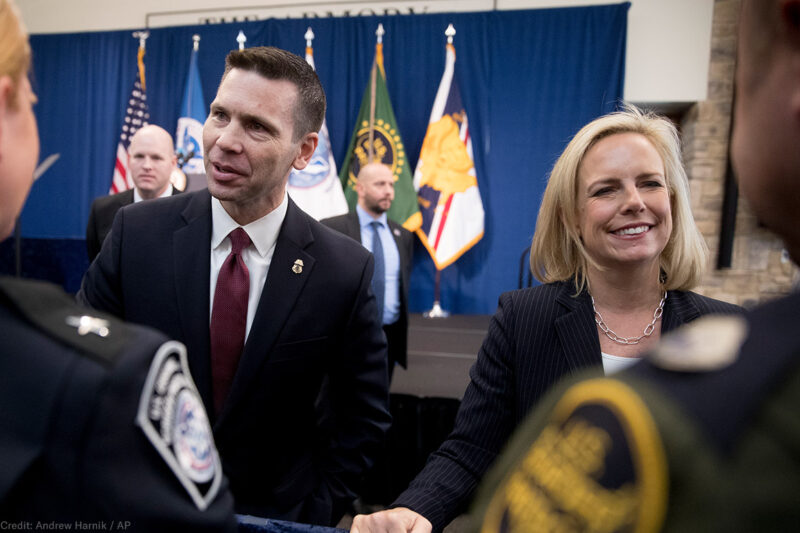
Last week, Secretary Kirstjen Nielsen of the Department of Homeland Security and Kevin K. McAleenan, Commissioner of Customs and Border Protection, testified at the same time in different congressional hearings. They seemed to be in a competition to see who could be more misleading about border realities.
Nielsen claimed that she lacked “context” to address what Politifact has determined to be false: President Trump’s claim in January that a border wall is justified since there were “never so many apprehensions ever in our history.” McAleenan continued to defend the administration’s obsession with preventing Central American families and children from applying for asylum, asking Congress to lengthen their detention and end the fair process they are due under U.S. and international law.
What dominated both hearings – one before the House Homeland Security Committee, and the other before the Senate Judiciary Committee -- was newly released data by CBP showing an increase in the number of people arriving at the southwest border. As the Trump administration uses these vulnerable migrants to justify its racist attacks on asylum seekers, there are three key points that you won’t hear in the administration’s propaganda.
First, the demographics of border arrivals have shifted. Those crossing the border are increasingly families and unaccompanied children -- they make up 61 percent in the new data. The number of apprehensions of individuals who are not juveniles continues to fall. This new reality makes Border Patrol agents’ mission different from what it had been because the majority of apprehensions now are not people evading detection. Instead, they are vulnerable families and children turning themselves in to Border Patrol agents so that they can seek asylum protection.
That’s key to the second point. These children and families should be able to apply for asylum at a port of entry but are prevented from doing so by the administration’s “metering” and “remain in Mexico” policies, in which agents force people to wait in Mexico for immigration proceedings in the United States.
Scared and vulnerable people are thus forced to choose between waiting for months in dangerous conditions in Mexico or crossing the border in between ports of entry and seeking out a Border Patrol agent to whom they can turn themselves in. Is it any surprise that they would choose the latter?
A survey by the Dilley Pro Bono Project of 500 detained asylum seekers held in the United States revealed that more than 90 percent said they did not feel safe in Mexico. Forty-six percent said that they or their child experienced “at least one type of harm” while in Mexico, including robbery, attempted robbery, threats, physical harm, kidnapping or attempted kidnapping, and sexual assault. Some 38 percent reported being mistreated by Mexican police.
So by turning back families unlawfully, the administration forces asylum seekers to cross the border elsewhere, and its own data show the shift. As CBP agents shut down access at ports of entry in May 2018, the number of migrants processed at ports began to fall, and the numbers crossing in between ports began to rise.
Third, DHS is including asylum seekers who arrive at ports without visas in the total number of apprehensions. McAleenan used this number-padding to claim that more than 750,000 people are expected to be apprehended this fiscal year, while Nielsen went over 900,000, apparently using seasonal projections.
In fact, the number of people crossing the border outside ports of entry is nowhere near a historic high. The new data put total arrivals for fiscal year 2019 on track to reach almost 650,000, but from 2000 to 2007, the number of border crossers was consistently near or over 1 million. The number reached as high as 1.6 million in 2000. Families and children seeking asylum did not make up significant proportions of those much higher numbers.
To process the current number of border crossers, CBP has more agents and money than ever before. The number of Border Patrol agents grew from 9,212 agents in 2000 to 12,349 in 2006, meaning each agent, on average, was responsible for between 81 and 173 apprehensions per year. Now, however, there are 19,555 Border Patrol agents, responsible for 32 apprehensions a year per agent. CBP’s budget has also more than doubled since 2006, growing from $7.1 billion in 2006 to $16.69 billion this year.
Instead of flooding CBP with more funds for a wall that symbolizes a cruel and outdated enforcement model, Congress should insist on a new mission for the agency that prioritizes due process, human rights, and migrant welfare, including access to asylum.


